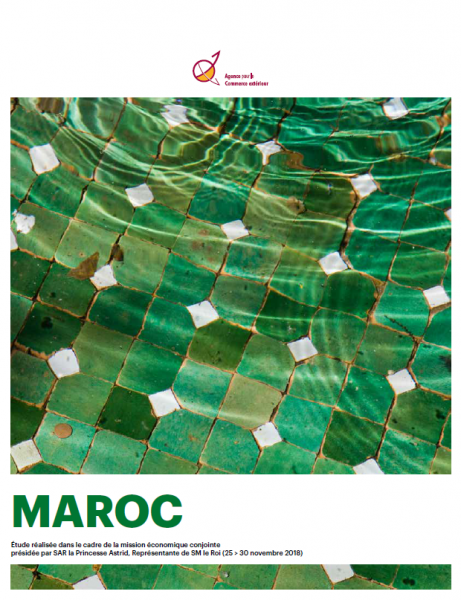The economic studies aim to provide the reader with a macroeconomic overview. They also list the key sectors that offer important opportunities for our Belgian export companies.
Economic study Mexico (January 2019)
Mexico has a large internal market, which is growing thanks to the reforms carried out under the ambitious Pacto por México programme. The country also has an extensive network of international trade agreements. New agreements with both the European Union and the United States & Canada are also in the pipeline. It is therefore an excellent time to discover the market.
This study was realised on the occasion of the Belgian economic mission to Mexico in February 2019.
Document only available in French and Dutch.Economic study Morocco (November 2018)
The Moroccan economy has undergone a strong transformation in the last twenty years and is in a very strong position today. A stable GDP growth of around 4% is expected in the coming years while inflation, interest and exchange rate are also stable. Morocco's ambition to serve as a bridge between Europe and Africa, along with other assets discussed in the study, make the country an attractive haven for investment. Additional focus in this study is on the logistics and transportation sector, infrastructure and energy.
This study was realised on the occasion of the Belgian economic mission to Morocco in November 2018.
Document only available in French and Dutch.Economic study New Zealand (October 2012)
Because of its geographical isolation, New Zealand is home to very special fauna and flora, much of which is endemic. It is not only New Zealand's great biodiversity that is important, but also its primary sector, whether it be fishing, farming, forestry or natural energy resources, that is flourishing.
Over the last 20 years, the government has succeeded in transforming this agriculturally, geographically and economically isolated New Zealand into an industrialised economy with free trade. Like many other Anglo-Saxon countries since the 1990s, New Zealand experienced a period of very strong growth during the 2000s. This lasted until the global economic crisis, during which the decline of the New Zealand economy was relatively limited.However, it is not only the natural resources and the primary sector that are important: New Zealand can also count on an internationally recognised film industry, without forgetting the importance of the construction and infrastructure sector.
During the economic mission to New Zealand, which was chaired by HRH Prince Philip from 27 to 30 November 2012, special attention was paid to these sectors.
This study was realised on the occasion of the Belgian economic mission to New Zealand in November 2012.
Document only available in French and Dutch.Economic study Oman (February 2014)
Oman has enjoyed a period of unprecedented economic progress over the last 40 years. This "boom" coincides with the reign of the current Sultan Qaboos bin Said al-Said, who came to power in 1970, and has been largely supported by the revenues of the oil sector (production and exports). In 2012, the oil sector accounted for almost 50% of GDP.
However, the high dependence on black gold makes the country vulnerable to shocks to the stock price of a barrel of crude oil. In response, the Sultanate launched Vision 2020 back in 1995, a long-term strategy built around three key components: "economic diversification, omanisation and privatisation". The key elements of this policy were subsequently developed and implemented through various five-year policy programmes, the most recent of which covers the period 2011-2015.
For the period 2013-2017, the Economist Intelligence Unit forecasts an average annual growth rate of 4.6%, 70% of which will be driven by growth in non-oil sectors, according to data from the Central Bank of Oman.
On the occasion of the joint Belgian economic mission to Oman (14-21 March 2014), the Belgian Foreign Trade Agency has published an economic study. The first chapter is devoted to Oman's macroeconomic situation, while the second contains an analysis of three dynamic sectors in which trade opportunities abound: infrastructure & logistics, energy & environment and the banking sector. This is followed by a selection of recent success stories of Belgian companies in Oman.
Document only available in French and Dutch.Economic study Peru (September 2014)
Thanks to its fertile soil, Peru has many assets to attract investors. Significant growth since 2000 has earned the country the flattering nickname "Tiger of the Andes". Macroeconomic indicators are also excellent, including controlled inflation, an enviable public debt and comfortable foreign exchange reserves.
The various free trade agreements are proof of the country's international openness and attract foreign investors. The simplification of procedures and the reduction of tariff barriers are boosting trade relations and facilitating market access for companies, especially thanks to the signing of the bilateral treaty with the European Union in spring 2013.
Year after year, Peru rises in the various rankings that assess the attractiveness and competitiveness of countries. Peru is also rated the second best South American nation by credit rating agencies.
On the occasion of the joint Belgian economic mission to Colombia and Peru from 18 to 25 October 2014, the Belgian Foreign Trade Agency published an 'economic study'. The first chapter is devoted to Peru's macroeconomic situation, while the second contains an analysis of four dynamic sectors in which trade opportunities abound: mines, energy, infrastructure and agro-industry. This is followed by a selection of recent success stories of Belgian companies in Peru.
Document only available in French and Dutch.
NEED MORE INFORMATION ABOUT OUR ECONOMIC STUDIES? CONTACT:
-
 Christelle CharlierDirector - Studies and Statistics
Christelle CharlierDirector - Studies and Statistics -

-





